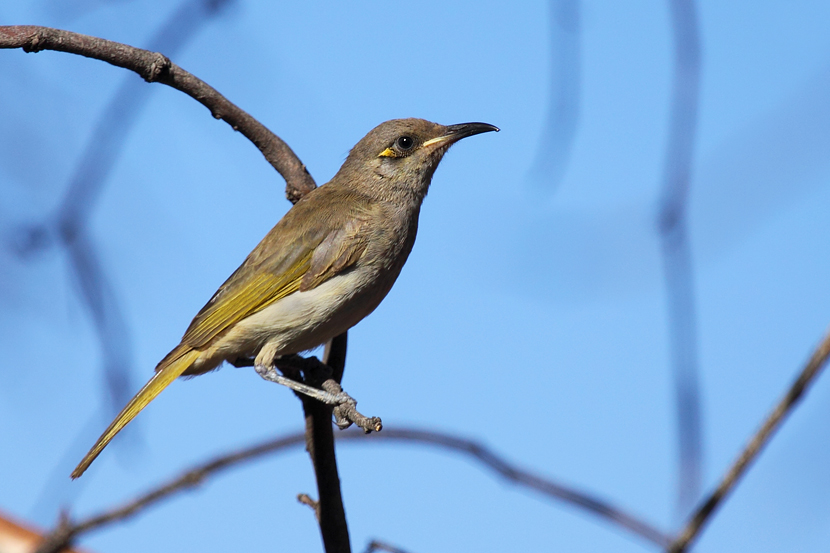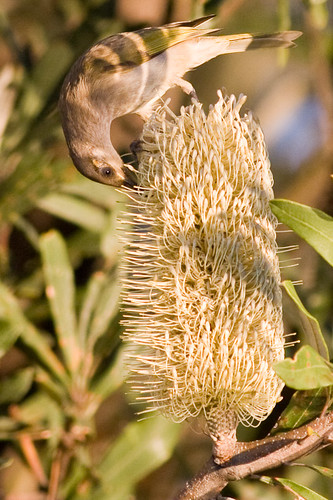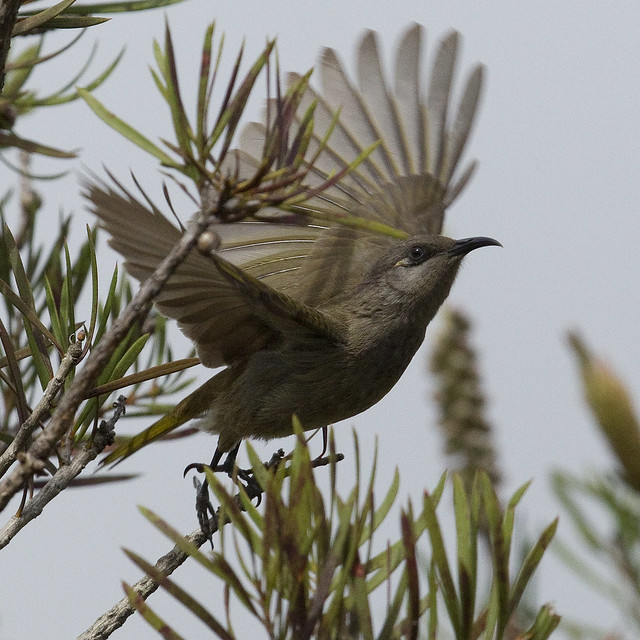Brown Honeyeater Biography







The Brown Honeyeater is a medium-small pale grey-brown honeyeater with a distinctive yellow tuft behind its eye. It also has yellow to olive wing patches and tail panels. It is pale grey below, darker olive brown above and has a long curved black bill. Young birds are paler with more yellow colouring and a yellow gape (open bill). It has a fast, undulating flight and is seen either singly, in pairs or small flocks in flowering trees and shrubs.
The Brown Honeyeater is similar to the Dusky Honeyeater, Myzomela obscura, in size and shape, but this species is much darker brown and lacks the tuft behind the eye and the yellowish wing patches. It could also be confused with females or young birds of the Scarlet Honeyeater, M. sanguinolenta, or Red-headed Honeyeater, M. erythrocephala, but these are smaller with shorter tails, lack the eye tuft, often have a reddish face and have very different calls.
The Brown Honeyeater is widespread in Australia , from south-western Australia across the Top End to Queensland , and through New South Wales on the eastern side of the Great Dividing Range to Swansea Lake Macquarie to the Parramatta River , Sydney , but is regularly recorded in suitable habitats such as Homebush Bay New South Wales to Tamworth and Gunnedah and south-west to Hillston. The Brown Honeyeater is also found in Bali and the Lesser Sundas, Indonesia , Aru Island and in parts of Papua New Guinea
The Brown Honeyeater is found in a wide range of wooded habitats, usually near water. It is often found in mangroves and woodlands or dense forests along waterways. It can also be found in mallee, spinifex woodlands, low dense shrublands, heaths and saltmarshes, as well as in monsoon forests or rainforests in the Top End. It is common in parks, gardens and street trees in urban areas as well as on farms and in remnant vegetation along roadsides.
The Brown Honeyeater feeds on nectar and insects, foraging at all heights in trees and shrubs. It may be seen in mixed flocks with other honeyeaters. In Western Australia
During the breeding season, male Brown Honeyeaters defend a nesting territory by singing from tall trees and they stand guard while the female builds the nest and lays the eggs. The small neat cup-nest is made from fine bark, grasses and plant down, bound with spiders web, and is slung by the rim in a shrub, fern or tree at up to 5 m from the ground and is usually very well-hidden by thick foliage. Only the female incubates, but both sexes feed the young. Nest predators include Pied Currawongs, snakes and cats. Brush Cuckoos, Pallid Cuckoos, Horsfield's Bronze-Cuckoos and Shining Bronze-Cuckoos will parasitise nests.
Browm Honeyeater

Brown Honeyeater

Brown Honeyeater

Brown Honeyeater

Brown Honeyeater

Browm Honeyeater

Brown Honeyeater

Brown Honeyeater
Brown Honeyeater
Brown Honeyeater (Lichmera Indinsticta)
Brown Honeyeater 2011/06/24(2)

No comments:
Post a Comment